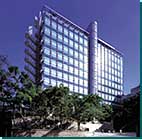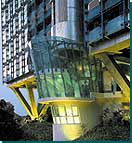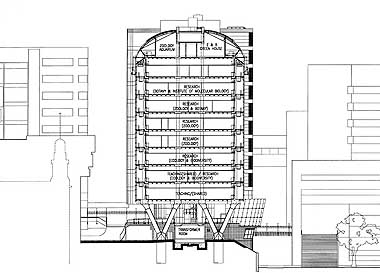| June
2000 |

 |
|
|
Kadoorie Biological Sciences Building
Beneath
the second skin
Overlooking the western
entrance to the University of Hong Kong, adjacent to the library
building, there now stands a gleaming mass of steel and glass which
has become the home of three life sciences departments and the Institute
of Molecular Biology.
To
be used principally for laboratory research, the ten-storey Kadoorie
Biological Sciences Building is the product of much research itself.
The
process began in early 1996, when, after the Kadoorie family had
decided to donate a building to the university, Leigh & Orange
Architects was appointed to design and supervise the building's
construction on a
site adjacent to Pokfulam Road that was formerly occupied by the
Chemistry Department.
Once
the university had decided to assign the building to the Zoology,
Botany and Ecology & Biodiversity departments for laboratory
work, the process of determining user requirements began. First
of all, though, Leigh & Orange had to face the challenge presented
by a tight and difficult site.

Main staircase lobby - external
view |
Support structure
The building is sited in a geotechnically sensitive area with nearby
slopes and large retaining walls. Appreciating that any additional
loading could have an adverse impact on existing ground conditions,
the architect sought to minimise the number of piles needed and
came up with a solution which required only eight large diameter
bored piles to be driven into the ground.
This
solution resulted in the creation of an inverted pyramidal support
structure with four columns tied to each pile to form a series of
"V" shapes at ground level. Circular columns formed by
PG glass reinforced concrete permanent formwork were initially considered
but gave way to fair-faced, rectangular columns due to the constructability
preferences of the appointed contractor.
Since
the building would be used for laboratory work, a high degree of
stiffness had to be provided to ensure the safe and accurate operation
of delicate instruments. This was achieved by the creation of two
reinforced concrete framed structures, one for each set of laboratory
suites, tied together in the central core by slabs and beams. Waffle
slabs were used for the floor plates, both to reduce the building's
weight and therefore
its dead load; and to provide the lateral structural rigidity required.
The facade
The building was designed with seven key issues in mind, namely:
functionality, flexibility, safety, energy efficiency, sustainability,
lifetime economy, buildability and ease of maintenance.
All
these considerations are reflected in all aspects of the building's
design, particularly
the facade. The Kadoorie Biological Sciences Building is the first
building in Hong Kong to fully exploit the green possibilities of
a second skin: an external glazed screen which is 2.5 m away from
the external wall.
The
building is clad in a combination of silver grey ceramic tiles and
glass and steel double skin. The north and south facades are clad
in ceramic tiles and the windows are protected by sunshading devices.
External maintenance walkways surround the building at each floor
level, providing safe and easy access for maintenance personnel.
According to Leigh & Orange associate Gabrielle Tsui, the horizontal
projections of the sunshade are calculated to strike a balance between
solar control and daylight penetration to the interior.
The
east and west facades are clad in a double-skin curtain wall which
serves several functions. It acts as a screen for the building services
installations distributed around the exterior of the building in
order to provide a flexible interior for the laboratories. Having
the building services installed on the exterior means maintenance
can be carried out without disturbing laboratory users and laboratories
are less likely to be contaminated. The security of the laboratories
is further enhanced by the provision of access to the building services
through external ducts and staircases.
The
fritted glass used for the screen wall serves to limit solar radiation
while the external services zone between the two layers of glazing
acts as a stack which channels hot air upwards for discharge into
the air, thus reducing the building's
solar heat gain. An open metal grille installed at each floor allows
free air circulation while serving as walkways for maintenance access.
Heat gain is further reduced by locating heat emitting equipment
in the external services zone outside the building, where they release
their heat into the void rather than the interior.
The
external glazed screens covering the east and west elevations are
suspended by steel roof trusses. According to Ms Tsui, since the
best structural capacity of steel is tension and not compression,
it is more efficient to load the material through a tensile structure
than as a rigid horizontal cantilevered steel structure which supports
the screen on every floor. When wind load imposes on the glass,
the loading is transferred via the bolts which hold the glass panels
together to the vertical steel tubes and the bow string structure
on the roof.

Short Section
The interior
The building provides 10,000 sq m of usable laboratory accommodation
which features a range of innovations which planners of similar
facilities here and elsewhere will be studying for some time.
To
make the most of the space available, the architect brought in UK
specialist laboratory planner Laboratories Investigation Unit to
provide advice on laboratory planning and to be responsible for
laboratory function design. With building services installations
moved to the perimeter of the building, the interior space is completely
freed up for laboratory facilities, which are served by a central
core which, in addition to connecting the two multi-storey laboratory
structures, also functions as a circulation core.
According
to the architect, maximum flexibility and adaptability governed
the design of the laboratory suites. Thought was also given to energy
efficiency and waste reduction. Each suite is a 3 m high, 24 m by
24.6 m shell with smooth, flush and easy to clean surfaces. The
suites are subdivided into 600 basic units using easily removable
metal partitions which are pressure-fixed between the floor and
the suspended ceiling.
Finding
pressure-jacked partitions capable of providing the necessary rigidity
was not easy. Similar partitions used at the City University in
Hong Kong and the Lloyds Building in London were studied but offered
little as both projects used partitions which still required mechanical
fixing on one side, whereas the Biological Sciences building required
top and bottom pressure-jacked partitions. Eventually the partition
supplier, Clestra Ltd, developed a partition which offered the required
rigidity and acoustic performance even with top and bottom jacking
pressure support. Better still, at a thickness of 60 mm, it is also
considerably slimmer than the partitions used in other projects,
which are about 100 mm thick.
The
partitions not only offer flexibility and rigidity, but also great
functionality. Aluminium wall rail channels fixed on the partitions
allow light switches, power sockets, shelves, cupboards, whiteboards
and coat hangers to be simply hung while remaining movable. Smaller
fixtures such as picture hooks and task lighting can be placed anywhere
on a partition by using magnets. This provides further flexibility
and adaptability to the need for change of usage in the internal
space.
Services
which enter the building vertically via a riser duct then horizontally
into the external services zone are fed into the 1.25 m deep ceiling
void on each floor. Flexible connectors distributed according to
the 3 m grid allow all the services needed - water, gas, compressed
air, electricity, telephone, etc - to be hooked up easily. Drainage
points are also provided regularly on all floors to allow flexible
internal space planning. They are connected where drainage is required;
where it is not necessary, a cover plate is installed. The floor
is paved with linoleum which, unlike artificial vinyl, is a natural,
biodegradeable material.
The
design concept of flexibility is consistent throughout, including
the internal fitting works. The modular design extends to the laboratory
benches, which are in the form of pre-plumbed/serviced spine units
which can be bolted together in various combinations according to
the layout.
A
particularly green feature of the building is the use of recirculatory
fume cupboards which only became commercially available recently.
Developed by the British Atomic Research Authority, the fume cupboards
utilise vortex fume scrubbing technology which, together with built-in
carbon filtration, make them recirculatory, thus cutting down on
the air-conditioning load of the building.
Since
they are moveable, these fume cupboards also contribute to the layout
flexibility of the laboratories. As they do not require a fixed
rooftop scrubber and extractor, a whole floor of plant space was
freed up, which allowed the architect to produce additional space
to accommodate the Institute of Molecular Biology. The re-designed
roof also accommodates greenhouses and an aquarium.
By
locating heat-emitting equipment in the external services zone and
using an external glazed wall as a sunshading device, without taking
into account various other energy-efficient and environmentally-friendly
design features in the building, the architect estimated that savings
of 53,360 KWH of energy per year, or 2.67 million KWH over 50 years,
can be achieved. Carbon dioxide emission is expected to be cut by
37.6 tonnes per year or 1.88 million tonnes over 50 years.
Built
at a cost of HK$500 million, which includes the cost of demolishing
the original chemistry building and site formation work, the Kadoorie
Biological Sciences Building demonstrates that a green, intelligent
building does not necessarily have to cost more than a conventional
building.
Judging
by the enquiries handled by the architect about this project, some
in the private property sector at least may just be getting the
message.
client The University
of Hong Kong
donor The Kadoorie Charitable Foundation
architect Leigh & Orange
structural, civil, geotechnical, acoustic and fire engineer Ove
Arup & Partners
laboratory specialist Laboratories Investigation Unit
main contractor Laing-Hip Hing Joint Venture
cost consultant Davis Langdon and Seah (HK)
landscape architect Hassell Ltd
external glazed screen Josef Gartner & Co (HK)
|


